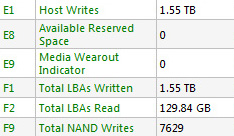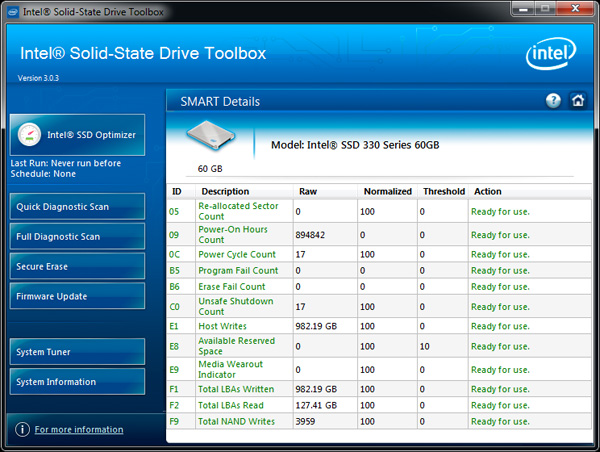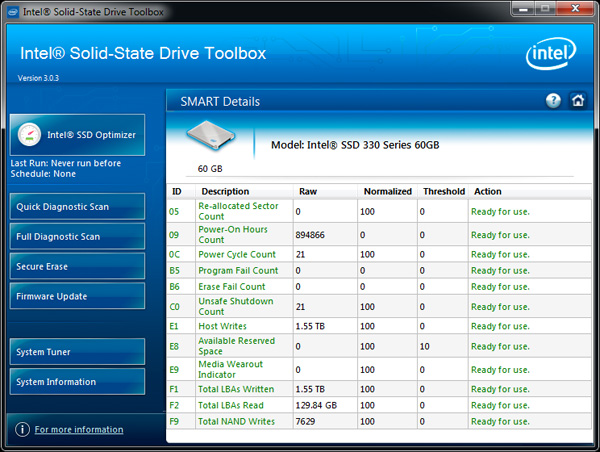The Intel SSD 330 Review (60GB, 120GB, 180GB)
by Anand Lal Shimpi on August 1, 2012 12:01 AM ESTLower Endurance: A Non-Issue
We've mentioned time and time again that NAND endurance is a non-issue for desktop (and even some enterprise) workloads.
Intel doesn't quantify the difference in endurance between the NAND used on the SSD 330 and the 520, it simply states that the 330's NAND will deliver a useful lifespan of 3 years and thus carries a 3 year warranty. Unfortunately, without access to the E2/E3/E4 counters we can't quickly figure out how long the 330 would last given a typical client workload. Thankfully Intel left one SMART wear indicator intact: the E9 attribute, otherwise known as the Media Wearout Indicator.
The normalized value of the E9 attribute (accessible via any SMART monitoring software, or Intel's SSD Toolbox) starts at 100 and decreases, linearly by integer increments, down to 0. Its meaning? The number of cycles the NAND media has undergone. At 100, your NAND is running at roughly full health. At 90, you've exhausted 10% of your NAND's lifespan. By the time the E9/MWI attribute gets down to 1 (99% of NAND p/e cycles have been used up) the counter stops decrementing and you're recommended to replace the drive. Even Intel admits however it's quite likely that at a value of 1 your drive will last for a considerable amount of time.
These are SandForce drives that implement real time data deduplication/compression so I wanted to create the worst case scenario to see how big of a deal this lower endurance NAND would be. I filled the 60GB Intel SSD 330 with incompressible data, leaving only its spare area untouched. I then ran a 4KB random write test, at a queue depth of 32, using incompressible data in four blocks of 6 hours, stopping only to look at the state of the E9/MWI attribute.
Even after 3959GB written to the 60GB drive, the media wear indicator remained at 100. If we do the math and assume that Intel isn't lying about the attribute decreasing linearly from 100 down to 0, it's possible the NAND on this particular 60GB SSD 330 is good for at least 6000 p/e cycles (3959GB/64GB = ~61 p/e cycles per NAND cell).
Not satisfied with these results I went in for another 24 hour round. By the end of it I had written 7629GB to the 60GB drive, at around 119 p/e cycles per NAND cell (assuming perfect wear leveling). The MWI hadn't budged:
Extrapolating based on this data you'd end up with over 10,000 p/e cycles for this particular drive. Whether or not this is accurate remains to be seen, but endurance is clearly not going to be an issue with Intel's SSD 330.
If you assume a typical client drive sees 10GB of writes per day, within a year you'd write 3650GB to the drive. I wrote that much in 24 hours. In fact, I wrote more than two years worth of data to the 60GB Intel SSD 330 in two days. All the while the Intel SSD 330 didn't even blink.
Note that as with any form of binning, you will see examples of drives that do better or worse than the one I've tested. Unless there's something horribly wrong with Intel's 25nm NAND process however, the difference is unlikely to be large enough where it'd be an issue.
As a side benefit to all of this experimenting with death is we can actually quantify write amplification on a SandForce drive.
Intel's 300i firmware, like all SandForce firmware, keeps track of NAND vs. host writes. Using that data I'm able to quantify write amplification during this fairly worst-case scenario workload:

7629GB of NAND writes vs. 1550GB of host writes = ~4.9x write amplification
SandForce maintains extremely low write amplification, even when faced with a hefty workload. Typical write amplification for client users will likely be far lower.












64 Comments
View All Comments
Kristian Vättö - Thursday, August 2, 2012 - link
Check back tomorrow ;-)antef - Wednesday, August 1, 2012 - link
Buy buy buy! Even less than what Anand's chart show. What a deal.bim27142 - Wednesday, August 1, 2012 - link
I am really torn between Samsung 830 128GB and Intel 330 180GB...I am just a typical user and a casual gamer... I've read good reviews about Samsung's performance at since it's not Sandforce based...
Capacity-wise, I really find the Intel 180GB just right enough for me... So I am really torn which one is better for my case... :(
mailrachit - Monday, August 13, 2012 - link
As 'a typical user and casual gamer' myself I was asking the same question Samsung 830 128 GB or Intel 330 180 GB just two months ago when I was making a new ivy bridge desktop rig.I went with Intel 330 180 GB and I must say that I am quite happy with my decision.
The performance is stellar. I trust Intel for reliability and God knows I need the extra space (180 GB - 128 GB).
Look for deals and you can get the Intel one for real cheap (I got it for $110).
angelsmaster - Tuesday, September 4, 2012 - link
hi, i just also bought the 330 series but now, its 240 gb.. did you update the firmware,, cause i cant seem to find one for th 240gb. i know its the same as 180gb model. but i can't seem to make the link work. btw. iam using macbook pro 15" 2011. thank...SewerSoldier - Thursday, August 2, 2012 - link
Hi,I'm currently looking at buying a 120/128GB system/application SSD for use beside a 1TB HDD for media.
I'm deciding between Samsung 830 Series and Intel 330. However in my country the samsung costs 130€ and the intel 112€.
My question is if I'm right in assuming that Intel 330 is the better choice since the better performance of the samsung with incompressible data isn't really important for a system/application drive?
softdrinkviking - Friday, August 3, 2012 - link
disappointed that intel hasn't come back with a new controller of their own. I own and love a 34nm intel drive, and I love how reliable it has been.it seems like intel can really put out good stuff when they put enough R&D into it, but I am not sure about their track record when working with other companies on tech. (like sandforce)
Per Hansson - Saturday, August 4, 2012 - link
Well honestly there have been reports of the "8MB bug" happening even with the latest firmware on the Intel 320 drive so I would not be so sure about that...http://communities.intel.com/thread/24339
http://communities.intel.com/message/162330
http://communities.intel.com/message/161880
softdrinkviking - Saturday, August 4, 2012 - link
Oh yeah, I forgot about that whole fiasco. Still, there is something I don't like about relying on data compression technology to speed up a drive. The potential for catastrophic data loss seems to be higher if you are dealing with multiple levels of logic abstraction. For similar reasons, I never used those drive doubler technologies that were popular before traditional HDDs became so big.Thinking about it from a data recovery point of view, how would this effect the difficulty and cost of recovering data from a drive?
I know the whole recovery process would be totally different from a HDD, but it still could be a consideration.
booomups - Thursday, August 30, 2012 - link
i really wonder about this, since it seems strange if intel says on some drives it does and in others it doesn make sense. in the review it says its enabled for the 180gb version, and not for the 120gb version. how certain is that even in newer drives revisions?and... intel doesnt mention e aes encryption for the 330 drives, but it is a big point for the 520 drives.
any details on that, ita the same chip after all.